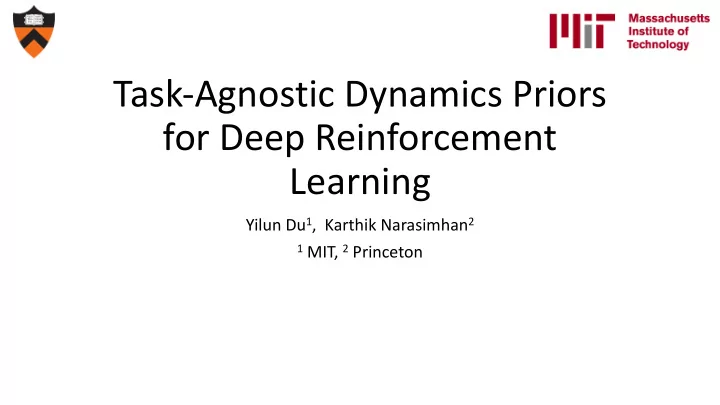

Task-Agnostic Dynamics Priors for Deep Reinforcement Learning Yilun Du 1 , Karthik Narasimhan 2 1 MIT, 2 Princeton
Key Questions t t+1 • Can we learn physics in a task-agnostic fashion? • Does it help sample efficiency of RL? • Can we transfer the learned physics from one environment to other?
Dynamics Model in RL • Frame Prediction (Oh et al.(2015), Finn et al.(2016), Weber et al. (2017), …) • Action conditional and not easily transferable across environments • Parameterized physics models (Cutler et al. (2014), Scholz et al.(2014), Zhu et al. (2018), …) • Requires manual specification • Our method: learn physics priors through task-independent data • Action unconditional modeling of data • Inductive local biases in architecture to reflect local nature of physics
Overall Approach • Pre-train a frame predictor on physics videos • Initialize dynamics model and use it to train a policy • Simultaneously fine-tune dynamics model on target environment.
SpatialNet • Two key operations: • Isolation of dynamics of each entity • Accurate modeling of dynamic interactions of local spaces around each entity SpatialNet h t z t Input Future Frame z t+1 h t+1 Spatial Memory
Spatial Memory • Use 2D grid memory to locally store dynamic state of each object • Use convolutions and residual connections to better model dynamics (instead of additive updates in the ConvLSTM model (Xingjian et al., 2015)) Spatial Memory State (h t ) Gated Input (i t ) State New (h t+1 ) C e C dyn C u C d Spatial Memory Ground State Output (o t ) Proposal State (u t ) Truth Label Input (z t ) State (h t ) Input (z t )
Spatial Memory • Use 2D grid memory to locally store dynamic state of each object • Use convolutions and residual connections to better model dynamics (instead of additive updates in the ConvLSTM model (Xingjian et al., 2015)) Spatial Memory State Input Frames
Experimental Setup • PhysVideos : 625k frames of video containing moving objects of various shapes and sizes PhysGoal PhysShooter • PhysWorld : Collection of 2D/3D Physics-centric games • Atari : Stochastic version with sticky actions • RL agent: Predicted frames stack with observation frames as joint input into a policy • Same prior for all tasks Phys3D PhysForage
Model Predictions Pixel Prediction Accuracy
Predicting Physical Parameters
Policy Learning: PhysShooter
Policy Learning: Atari
Transfer Learning Model Transfer > Model + Policy Transfer > No Transfer
Conclusion • Task-agnostic priors over models provide a potential solution for improving sample efficiency for RL • Being task-agnostic allows us to pre-train priors without access to the target task • Such priors also generalize well to a wide variety of tasks and show good transfer performance
Recommend
More recommend